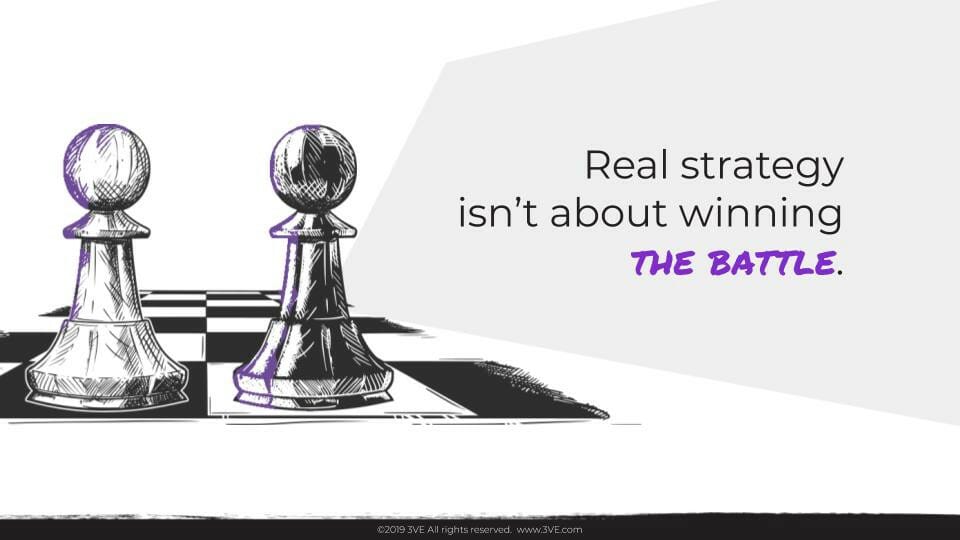The Evolution of Strategy (Made Less Dull)
Alternatively: Real Strategy (not the Silicon-Valley-obsessed, frivolous, impractical google search queries disguised as innovation & innovation) Has Real Roots

Okay. Let’s be honest. When it comes to talking about the history of strategy, especially when the speaker comes from a team like ours, the topic can often get dry — well, very dry — quite quickly. No matter how good the PowerPoints may be and how many graphical touches one can throw into the presentation or the article, the audience just sees a constant thread of guys — yes, mostly guys (Sorry, not being misogynistic, just reporting here…) — saying, in essence, “Well, here’s how to do things…”
Throughout most of human history, people just did things… and sometimes great, massive, important things! Yet, until very recent times, relatively speaking, people just did them! Generals won battles. Leaders led countries. Politicians got things done for the people (OK, well, as the great modern philosopher Meatloaf famously sang in his seminal work, Bat Out of Hell, “Now don’t be sad, cause two out of three ain’t bad…”).

Some trace the idea of strategic thinking back as far as the B.C. period — think Moses managing — well, not so successfully — that little 40 year trip from Egypt to the Promised Land. Yes, the Bible can be viewed as a succession of successful (think Noah), unsuccessful (think the mayor of Sodom…), and long-term comeback (think J.C.) strategies. Yet, the idea of writing out how you got you things done, what your thinking was behind those actions, and what lessons you might have learned in the process is mostly regarded as an A.D. (not Anthony Davis for you NBA groupies) phenomenon.
Most trace the concept of strategy — as something that you not just did, but shared with the world — to the Chinese general Sun Tzu and his masterwork, The Art of War. Still, over a millennium later and half a world away, Suz Tzu’s work is influential in not just military strategy, but how we manage all organizations. He was one smart dude, as he had advice leaders still take heed of today — or should — on when to fight and when to avoid the fight.
And while not exactly a popular fellow with a good reputation, Niccolò Machiavelli, also became famous for sharing his strategic thinking with the world beyond Italian politics of the Renaissance. Without The Prince, we would not have what is basically a still-oft consulted work on the strategy of power and a whole school of thought — Machiavellianism — a philosophy and mindset on strategy that one can trace directly from the Italy of the 16th Century to corporate boardrooms and the halls of the Capitol in Washington today.
Strategy, for the longest time, was not however thought of in the corporate sense, but in the military realm. Indeed, the history of strategy began as a study of how military leaders planned and executed their campaigns, and it was largely the work of historians. For while today we take for granted that if you “get” Osama Bin Laden, well, you have to write a book about it (The Operator) and have a major Hollywood film made on how it was done (Zero Dark Thirty). We don’t have the strategy books from the likes of either the “winners” like Ulysses S. Grant or Dwight Eisenhower or the “losers” like Robert E. Lee or Napoleon Bonaparte. Rather, many historians over the years have written many, many words analyzing what worked for them — and what didn’t.
The 19th and early 20th Centuries were pivotal when we look at how we came to think more of strategy in the business sense, rather than in the military realm. With the advent of railroads spreading across the expanse of America and the first really, really large industrial organizations developing in areas from steel to oil to automobiles and more, the entrepreneurs who led these companies looked for models on how to best manage these big, often far-flung enterprises. Really the only comparable organizations in size and complexity were to be found in the world’s militaries, and so much of the way that we think about — and actually manage- the strategy of companies comes from the military model. And that is why so very much of the language of strategy — mission, goals, objectives, tactics, maneuvers, and more — can be traced directly from the war room to the board room.
Another factor that has been critical in the development of business strategy as a way of thinking and doing — and as a field of academic study — is that when it comes to the world of free enterprise, there is a desire — and a motivation (yes, money does motivate) — to find and to share what works! So yes, in the early 20th Century, the “Scientific Management” of Frederick Taylor (he was quite a nutjob, but got things done) and Frank and Lillian Gilbreth (if you’ve seen either version of “Cheaper by the Dozen” — the 1950 or 2003 movies — that’s their family “efficiency” story!) came to the fore, and we began to study management as a replicable “thing” — and there was “one best way” to get things done.
And beyond managing individuals, the study of management evolved to encompass the strategy of the whole enterprise. As such, strategic management soon became a discipline in its own right. Urged on by the findings of a major 1954 study from the Ford Foundation, colleges everywhere instituted so-called “capstone” courses. Labelled “business strategy” or “business policy,” studying strategic management has been required of every business school major on the planet ever since. If you know a business major, regardless of age, just ask them what company their “policy project” was about? That simple question could send them into post-traumatic stress!
For much of the last 50 years then, there has been a great deal of specialized research done on the strategic management of all forms of organizations — for-profit, non-profit, big, small, public, private, and governmental. From the halls of academia to one of the many strategic consulting firms that have proliferated not just in the U.S., but worldwide, the study of strategy has had its own “steroid era” — as firms seek their own home runs by building on the success of strategies — and more importantly, the strategic thinking and processes — that actually produce results!
And in turn, the strategy of business has become, in many ways, the business of strategy — and it has been a very good business over time! What we have seen is a dizzying succession of ideas put forward by strategy “gurus” — and ah, it is great to be a strategy guru (Hey, I’m still trying!). Every few years, a new “rock star” seemed to emerge in strategy, becoming the “Management Elvis” of his day. These men changed the course of business history, and their strategic ideas have lingering influence on organizations all around the world. They include:
- W. Edwards Deming’s and his “14 points” (from Out of the Crisis);
- Tom Peters and Bob Waterman’s “7-S Model” (from In Search of Excellence);
- Michael Porter and his ideas on both the “Five Forces” and the “Generic Competitive Strategies” (from Competitive Strategy); and
- Michael Hammer and James Champy’s concept of “Reengineering” (from Reengineering the Corporation).
The beat simply goes on and on and on, as ideas like managing the value chain, lean manufacturing, Six Sigma, the balanced scorecard, the triple bottom-line and green management have come to the fore.
And since the field of strategy tends to be inclusive, if a bit “faddish,” there seems to be a place for all of these different ideas and approaches under the very big tent that the study of strategic management has become. Determining which one is the right one for your particular organization at one particular point in time does bring the art and science of practicing management together. Finding the right approach — and the right tool — is what separates the very good consultants, advisors, and top executives from the rest.
And yes, all this “situationality” leads to the greatest piece of strategic management advice that one can ever receive. These two words of advice come from the contingency approach to management, which holds that literally, the answer to every possible situation begins with the two magic words that will propel you to that corner office: “It depends…”
Today, it does depend more than ever, as managers, from those who own the smallest of businesses to those who lead the largest of the Fortune 500, have a great deal of strategic management knowledge to call upon. And we need strategic thinking now more than ever, as organizations the world over deal with sweeping changes in technology, economic uncertainty, demographic and cultural shifts and much, much more — all seemingly happening simultaneously and faster today than ever before.
The great management philosopher, former boxing heavyweight champion and now actor Mike Tyson put it best: “Everybody has a plan until they get punched in the mouth.” Today, every company and every person needs to be able to plan effectively, and yet, to be able to react effectively once conditions change — especially when they might not be favorable for you. And the body of knowledge, tools and thinking that has evolved in the field of strategy — from Sun Tzu to the writers of today — provides all of us with a rich, treasure trove to draw upon as we negotiate the complexities of our modern, highly connected and extremely competitive world. The how of how to do all of this is what separates the truly exceptional performing companies from the rest — and that is why the “strategy business” — for all its faults — will continue to be a presence far, far into the future.
With major contributions from David Wyld, a Professor of Strategic Management at Southeastern Louisiana University in Hammond, Louisiana. He is a management consultant, researcher/writer, publisher, executive educator, and experienced expert witness.



